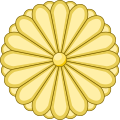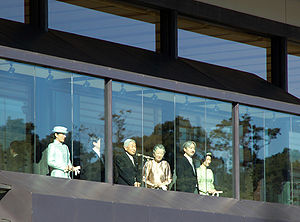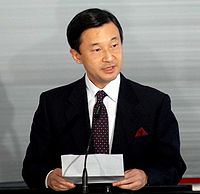- Imperial House of Japan
-
For the administration of the Imperial household, see Imperial Household Agency.
Imperial House of Japan 
Country Japan Titles Emperor of Japan Founder Emperor Jimmu Current head Akihito Founding 660 BC (traditional) Cadet branches - Akishino-no-miya
- Hitachi-no-miya
- Mikasa-no-miya
- Katsura-no-miya
- Takamado-no-miya
The Imperial House of Japan (皇室 kōshitsu), also referred to as the Imperial Family or the Yamato Dynasty, comprises those members of the extended family of the reigning Emperor of Japan who undertake official and public duties. Under the present Constitution of Japan, the emperor is the symbol of the state and unity of the people. Other members of the imperial family perform ceremonial and social duties, but have no role in the affairs of government. The duties as an emperor are passed down the line to children and their children's children and so on.
The Japanese monarchy is the oldest continuous hereditary monarchy in the world. The imperial house recognizes 125 monarchs beginning with the legendary Emperor Jimmu (traditionally dated to February 11, 660 BC) and continuing up to the current emperor, Akihito; see its family tree. However, there is no historical evidence for the genealogical relationships, and in most cases even the existence of, the first 25 emperors.
Contents
List of current members
 from left to right: Crown Princess Masako, Crown Prince Naruhito, the Emperor, Empress Michiko, Prince Akishino, Princess Kiko; on the occasion of the Emperor's Birthday at the Tokyo Imperial Palace; 2005
from left to right: Crown Princess Masako, Crown Prince Naruhito, the Emperor, Empress Michiko, Prince Akishino, Princess Kiko; on the occasion of the Emperor's Birthday at the Tokyo Imperial Palace; 2005
The 1947 Imperial Household Law defines the imperial house as: the Emperor of Japan (天皇 tennō); the empress (皇后 kōgō); the empress dowager (皇太后 kōtaigō); the grand empress dowager (太皇太后 tai-kōtaigō); the crown prince (皇太子 kōtaishi) and his consort (皇太子妃 kōtaishihi); the imperial grandson who is heir apparent (kōtaison, 皇太孫) and his consort; the male-line Imperial grandsons (親王 shinnō) and their consorts; the unmarried male-line Imperial granddaughters (内親王 naishinnō); Imperial Princes (王 ō) and their consorts; and the Imperial Princesses (女王 nyoō). The legitimate children and male line grandchildren of an emperor are 親王 shinnō (imperial princes) in the case of males and 内親王 naishinnō (imperial princesses) in the case of females. More distant male line descendants are ō (princes) or nyoō (princesses).
After the removal of eleven collateral branches from the Imperial House in October 1947, the official membership of the imperial family has effectively been limited to the male line descendants of the Emperor Taishō, excluding females who married outside the imperial family and their descendants.
There are presently 23 members of the imperial family:
- The Emperor was born at the Imperial Palace in Tokyo on 23 December 1933, the elder son and sixth child of the Shōwa Emperor and Empress Kōjun. He was married on 10 April 1959 to Michiko Shōda. Emperor Akihito succeeded his father as emperor on 7 January 1989.
- The Empress, formerly Michiko Shoda, was born in Tokyo on 24 October 1934, the eldest daughter of Hidesaburo Shoda, president and honorary chairman of Nisshin Flour Milling Inc..
- Naruhito, Crown Prince of Japan, the eldest son of the Emperor and the Empress, was born at the Tsugo Palace in Tokyo on 23 February 1960. He became heir apparent upon his father's ascension to the throne. Crown Prince Naruhito was married on 10 June 1993 to Masako Owada. The Crown Prince and Crown Princess have one daughter.
- Masako, Crown Princess of Japan was born on 9 December 1963, the daughter of Hisashi Owada, a former vice minister of foreign affairs and former permanent representative of Japan to the United Nations.
- Aiko, Princess Toshi, who was born on 1 December 2001 and who holds the childhood title "Princess Toshi".
- The Prince Akishino, the Emperor's second son, was born on 11 November 1965. His childhood title was Prince Aya. He received the title Prince Akishino and permission to start a new branch of the imperial family upon his marriage to Kawashima Kiko on 29 June 1988.
- The Princess Akishino was born on 11 September 1966, the daughter of Kawashima Tatsuhiko, professor of economics at Gakushuin University. Prince and Princess Akishino have two daughters and a son:
- Princess Mako of Akishino (born 23 October 1991)
- Princess Kako of Akishino (born 29 December 1994)
- Prince Hisahito of Akishino (born 6 September 2006)
- The Prince Hitachi was born on 28 November 1935, the second son and seventh child of the Emperor Shôwa and Empress Kojun. His childhood title was Prince Yoshi. He received the title Prince Hitachi and permission to set up a new branch of the imperial family on 1 October 1961, the day after his wedding. The Princess Hitachi was born on 19 July 1940, the daughter of former Count Tsugaru Yoshitaka. Prince and Princess Hitachi have no children.
- The Prince Mikasa was born on 2 December 1915, the fourth son of the Taisho Emperor and Empress Teimei. He is the surviving brother of Emperor Shōwa and the surviving paternal uncle of Emperor Akihito. His childhood title was Prince Sumi (Sumi-no-miya). He received the title Prince Mikasa and permission to start a new branch of the imperial family on 2 December 1935. He married on 22 October 1941. The Princess Mikasa was born on 6 June 1923, the second daughter of Viscount Takagi Masanori. Prince and Princess Mikasa have two daughters and three sons.
- Prince Tomohito of Mikasa is the eldest son of the Prince and Princess Mikasa and a first cousin of Emperor Akihito. He is also heir apparent to his father's title, Mikasa-no-miya. He was born on 5 January 1946. Prince Tomohito married Aso Nobuko on 7 November 1980. Nobuko, Princess Tomohito of Mikasa was born on 9 April 1955, the daughter of Aso Takakichi, chairman of Aso Cement Co. and his wife, Kazuko, a daughter of former prime minister Yoshida Shigeru. Prince and Princess Tomohito of Mikasa have two daughters:
- Princess Akiko of Mikasa (born 20 December 1981)
- Princess Yōko of Mikasa (born 25 October 1983)
- The Prince Katsura is the second son of Prince and Princess Mikasa and a first cousin of Emperor Akihito. He was born on 11 February 1948. Originally known as Prince Yoshihito of Mikasa, he received the title Prince Katsura (Katsura-no-miya) and authorization to start a new branch of the imperial family on 1 January 1988.
- The Princess Takamado is the widow of the Prince Takamado (born 29 December 1954, died 21 November 2002), the third son of the Prince and the Princess Mikasa and a first cousin of Emperor Akihito. The princess was born 10 July 1953, the daughter of Tottori Shigejiro. She married the prince on 6 December 1981. Originally known as Prince Norihito of Mikasa, he received the title Prince Takamado and permission to start a new branch of the imperial family on 1 December 1981. Princess Takamado has three daughters:
- Princess Tsuguko of Takamado (born 6 March 1986)
- Princess Noriko of Takamado (born 22 July 1988)
- Princess Ayako of Takamado (born 15 September 1990)
- Prince Tomohito of Mikasa is the eldest son of the Prince and Princess Mikasa and a first cousin of Emperor Akihito. He is also heir apparent to his father's title, Mikasa-no-miya. He was born on 5 January 1946. Prince Tomohito married Aso Nobuko on 7 November 1980. Nobuko, Princess Tomohito of Mikasa was born on 9 April 1955, the daughter of Aso Takakichi, chairman of Aso Cement Co. and his wife, Kazuko, a daughter of former prime minister Yoshida Shigeru. Prince and Princess Tomohito of Mikasa have two daughters:
Family tree
The following family tree shows the lineage of the current members of the Imperial family (living members in bold). Princesses who left the imperial family upon their marriage are indicated in italics:[1]
Living former members
Under the terms of the 1947 Imperial Household Law, naishinnō (imperial princesses) and nyoō (princesses) lose their titles and membership in the imperial family upon marriage, unless they marry the Emperor or another member of the imperial family. Three of the five daughters of Emperor Shōwa, the two daughters of Prince Mikasa, and most recently, the only daughter of the Emperor Akihito left the imperial family upon marriage, taking the surnames of their husbands. The eldest daughter of Emperor Shōwa married the eldest son of Prince Higashikuni Naruhiko in 1943. The Higashikuni family lost its imperial status along with the other collateral branches of the imperial family in October 1947. The living former imperial princesses are:
- Atsuko Ikeda, born 7 March 1931, fourth daughter of Emperor Shōwa and surviving elder sister of Emperor Akihito.
- Takako Shimazu, born 2 March 1939, fifth daughter and youngest child of Emperor Shōwa and younger sister of Emperor Akihito.
- Yasuko Konoe, born 26 April 1944, eldest daughter and eldest child of Prince and Princess Mikasa.
- Masako Sen, born 23 October 1951, second daughter and fourth child of Prince and Princess Mikasa.
- Sayako Kuroda, born 18 April 1969, third child and only daughter of Emperor Akihito and Empress Michiko.
In addition to these former princesses, there are also several people of Imperial descent in the eleven cadet branches of the dynasty (Asaka, Fushimi, Higashi-Fushimi, Higashi-kuni, Kan'in, Kaya, Kitashirakawa, Kuni, Nashimoto, Takeda, and Yamashina) that left the imperial family in October 1947. The Shōwa emperor's eldest daughter, Higashikuni Morihito (Shigeko), and his third daughter, Takatukasa Toshimichi (Kazuko), died in 1961 and 1989, respectively.
Succession
See also: Emperor of Japan#SuccessionHistorically, the succession to the Chrysanthemum Throne has generally passed in male line of the imperial lineage. The imperial clan previously included specially designated collateral lines or shinnōke (princely houses), too. The surviving shinnōke and several other branches of the extended imperial clan (the ōke) were reduced to commoner status in 1947.
Before the Meiji Restoration, Japan had eight female tennō or reigning empresses, all of them daughters of male line of the imperial clan. None ascended purely as a wife or as a widow of an emperor. None of these empresses married or gave birth after ascending the throne.
Article 2 of the Constitution of Japan provides that "the Imperial Throne shall be dynastic and succeeded to in accordance with the Imperial Household Law passed by the Diet." The Imperial Household Law of 1947 enacted by the 92nd and last session of the Imperial Diet, retained the exclusion on female dynasts found in the 1889 law. The government of Prime Minister Yoshida Shigeru hastily cobbled together the legislation to bring the Imperial House in compliance with the American-written Constitution of Japan that went into effect in May 1947. In an effort to control the size of the imperial family, the law stipulates that only legitimate male descendants in the male line can be dynasts; that naishinnō (imperial princesses) and nyoō (princesses) lose their status as imperial family-members if they marry outside the imperial family; that shinnō (imperial princes), other than the crown prince, ō (princes), unmarried imperial princesses and princesses, and the widows of imperial princes and princesses may, upon their own request or in the event of special circumstances, renounce their membership in the imperial family with approval of the Imperial House Council; and that the Emperor and other members of the imperial family may not adopt children.
Before September 2006, there was a potential succession crisis since no male child had been born into the imperial family since Prince Akishino in 1965. Following the birth of Princess Aiko, there was some public debate about amending the Imperial House Law to allow female descendants of an emperor and their descendants to succeed to the throne. In January 2005, Prime Minister Koizumi Junichiro appointed a special panel of judges, university professors, and civil servants to study changes to the Imperial House Law and to make recommendations to the government. On October 25, 2005, the commission recommended amending the law to allow females in the male line of imperial descent to succeed to the throne. Since the birth of a male son to another of Akihito's children the issue has been left in abeyance by both the public and successive governments. Also see Japanese Imperial succession controversy.
History of titles
Ō (王) is a title (commonly translated "prince") given to male members of the Japanese Imperial Family who do not have the higher title of shinnō. The female equivalent is joō/nyoō (女王). Ō can also be translated as "king". The origin of this double meaning is a copying of the Chinese pattern. Unlike in China, however, ō was only used for imperial family members.
Historically, any male member of the Imperial Family was titled ō by default, with shinnō (親王; literally relative-prince) and its female equivalent naishinnō (内親王; literally relative-princess) being special titles granted by the Emperor. After the Meiji Restoration, the difference between ō and shinnō were altered. A shinnō or naishinnō was a legitimate Imperial Family member descended from an Emperor down to the great grandchild. The term "legitimate Imperial Family" excludes anyone not connected by a direct male line descent, as well as the descendants of anyone who renounced their membership in the Imperial Family, or were expelled from the Imperial Family. Shinnō also included the heads of any of the shinnōke. A provision of law which never had an opportunity to be applied also stipulated that if the head of a shinnōke succeeded to the Chrysanthemum Throne, then his brothers would acquire the title of shinnō, as well as their descendants (down to the grandchildren?). The Emperor could also specially grant the title of shinnō to any ō.
In 1947, the law was changed so that shinnō only extended to the male-line grandchildren of an Emperor. The Imperial Family was also drastically pruned, disestablishing the ōke and shinnōke. The consort of an ō or shinnō has the suffix -hi (妃) to ō or shinnō.
See also
Related terms
References
External links
Categories:- Japanese Imperial Family
- Japan-related lists
- Dynasty genealogy
Wikimedia Foundation. 2010.



